Burt A. The Evolution of the British Empire and Commonwealth From the American Revolution
Подождите немного. Документ загружается.

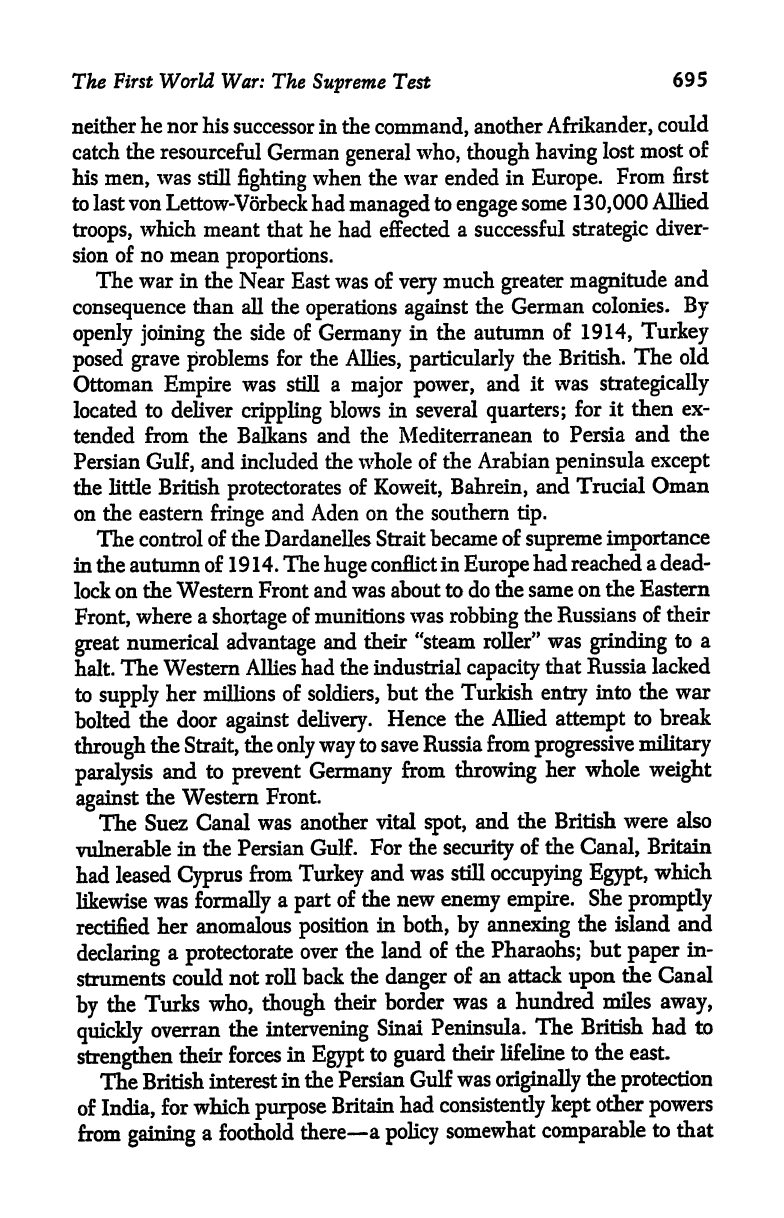
The
First
World
War: The
Supreme
Test
695
neither
he
nor
his
successor
in the
command,
another
Afrikander,
could
catch
the
resourceful
German
general
who,
though
having
lost
most
of
his
men,
was
still
fighting
when the
war ended
in
Europe.
From
first
to
last von
Lettow-Vorbeck
had
managed
to
engage
some
130,000
Allied
troops,
which
meant that
he
had
effected
a
successful
strategic
diver-
sion
of
no
mean
proportions.
The war in
the Near East
was of
very
much
greater
magnitude
and
consequence
than
all the
operations
against
the
German
colonies.
By
openly joining
the side of
Germany
in
the
autumn
of
1914,
Turkey
posed
grave problems
for the
Allies,
particularly
the British.
The
old
Ottoman
Empire
was still
a
major power,
and
it
was
strategically
located
to deliver
crippling
blows
in several
quarters;
for
it
then
ex-
tended
from
the
Balkans
and the Mediterranean
to Persia
and
the
Persian
Gulf,
and included
the
whole
of
the
Arabian
peninsula
except
the
little
British
protectorates
of
Koweit,
Bahrein,
and
Trucial Oman
on
the
eastern
fringe
and
Aden
on
the
southern
tip.
The control
of
the Dardanelles
Strait
became
of
supreme
importance
in the
autumn of
19
14. The
huge
conflict
in
Europe
had
reached
a
dead-
lock
on
the
Western
Front
and
was about to do
the
same
on the
Eastern
Front,
where
a
shortage
of
munitions
was
robbing
the Russians of
their
great
numerical
advantage
and
their "steam roller"
was
grinding
to
a
halt.
The Western
Allies
had
the
industrial
capacity
that
Russia lacked
to
supply
her millions
of
soldiers,
but
the
Turkish
entry
into
the
war
bolted
the door
against
delivery.
Hence
the Allied
attempt
to break
through
the
Strait,
the
only way
to save
Russia from
progressive
military
paralysis
and
to
prevent
Germany
from
throwing
her
whole
weight
against
the
Western
Front.
The Suez
Canal
was
another
vital
spot,
and
the
British
were
also
vulnerable
in the
Persian
Gulf.
For the
security
of
the
Canal,
Britain
had leased
Cyprus
from
Turkey
and
was still
occupying
Egypt,
which
likewise
was
formally
a
part
of
the new
enemy
empire.
She
promptly
rectified
her
anomalous
position
in
both,
by annexing
the island
and
declaring
a
protectorate
over
the
land
of
the
Pharaohs;
but
paper
in-
struments
could
not
roll
back
the
danger
of
an
attack
upon
the
Canal
by
the
Turks
who,
though
their
border
was
a hundred
miles
away,
quickly
overran
the
intervening
Sinai
Peninsula.
The British had to
strengthen
their
forces
in
Egypt
to
guard
their lifeline
to the
east.
The
British
interest
in
the
Persian
Gulf
was
originally
the
protection
of
India,
for
which
purpose
Britain
had
consistently kept
other
powers
from
gaining
a foothold
there
a
policy
somewhat
comparable
to that
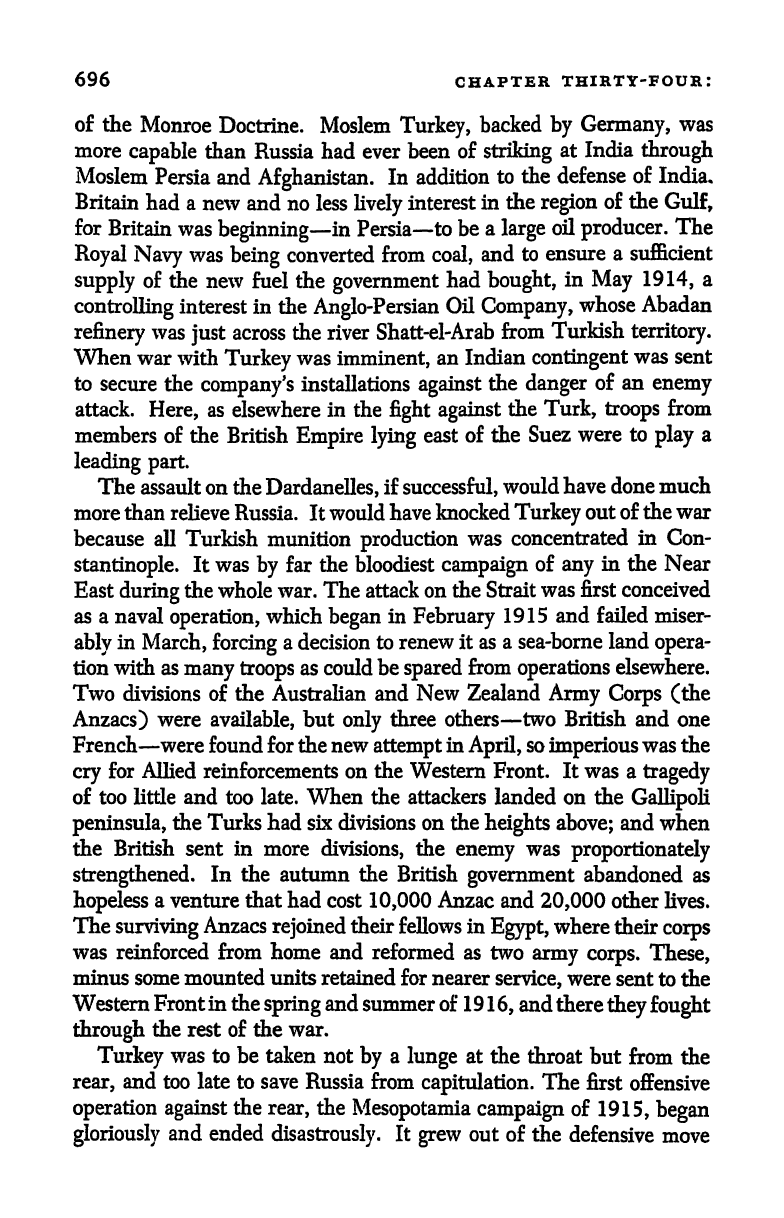
696
CHAPTER
THIRTY-FOUR:
of
the
Monroe
Doctrine. Moslem
Turkey,
backed
by
Germany,
was
more
capable
than
Russia had
ever
been
of
striking
at
India
through
Moslem
Persia and
Afghanistan.
In addition
to the
defense
of
India.
Britain
had a
new and
no less
lively
interest
in
the
region
of
the
Gulf,
for
Britain
was
beginning
in
Persia
to be
a
large
oil
producer.
The
Royal
Navy
was
being
converted
from
coal,
and
to
ensure
a
sufficient
supply
of
the
new
fuel the
government
had
bought,
in
May
1914,
a
controlling
interest in the
Anglo-Persian
Oil
Company,
whose Abadan
refinery
was
just
across the river
Shatt-el-Arab
from
Turkish
territory.
When
war
with
Turkey
was
imminent,
an Indian
contingent
was sent
to
secure
the
company's
installations
against
the
danger
of
an
enemy
attack.
Here,
as
elsewhere
in the
fight
against
the
Turk,
troops
from
members
of
the
British
Empire lying
east
of the
Suez
were
to
play
a
leading
part.
The
assault on the
Dardanelles,
if
successful,
would
have done
much
more
than
relieve Russia.
It would
have
knocked
Turkey
out of
the
war
because
all Turkish munition
production
was
concentrated
in
Con-
stantinople.
It
was
by
far
the
bloodiest
campaign
of
any
in the Near
East
during
the
whole
war. The attack
on
the Strait
was first conceived
as
a naval
operation,
which
began
in
February
1915 and failed miser-
ably
in
March,
forcing
a
decision
to
renew it as
a sea-borne land
opera-
tion with as
many troops
as could
be
spared
from
operations
elsewhere.
Two divisions
of
the Australian and
New
Zealand
Army Corps
(the
Anzacs)
were
available,
but
only
three others
two British
and
one
French
were
found
for
the new
attempt
in
April,
so
imperious
was
the
cry
for
Allied
reinforcements on
the Western
Front.
It
was a
tragedy
of too
little
and
too
late.
When the attackers landed on
the
Gallipoli
peninsula,
the Turks had
six divisions on
the
heights
above;
and
when
the
British
sent
in
more
divisions,
the
enemy
was
proportionately
strengthened.
In
the autumn the
British
government
abandoned
as
hopeless
a
venture that had cost
10,000
Anzac and
20,000
other
lives.
The
surviving
Anzacs
rejoined
their
fellows
in
Egypt,
where
their
corps
was
reinforced
from home
and
reformed as two
army
corps.
These,
minus
some mounted
units
retained for nearer
service,
were
sent
to
the
Western
Front
in the
spring
and
summer of 19 1
6,
and there
they
fought
through
the
rest of
the
war.
Turkey
was to be taken
not
by
a
lunge
at
the throat
but
from
the
rear,
and
too late to save
Russia
from
capitulation.
The
first
offensive
operation against
the
rear,
the
Mesopotamia
campaign
of
1915,
began
gloriously
and
ended
disastrously.
It
grew
out of
the
defensive
move
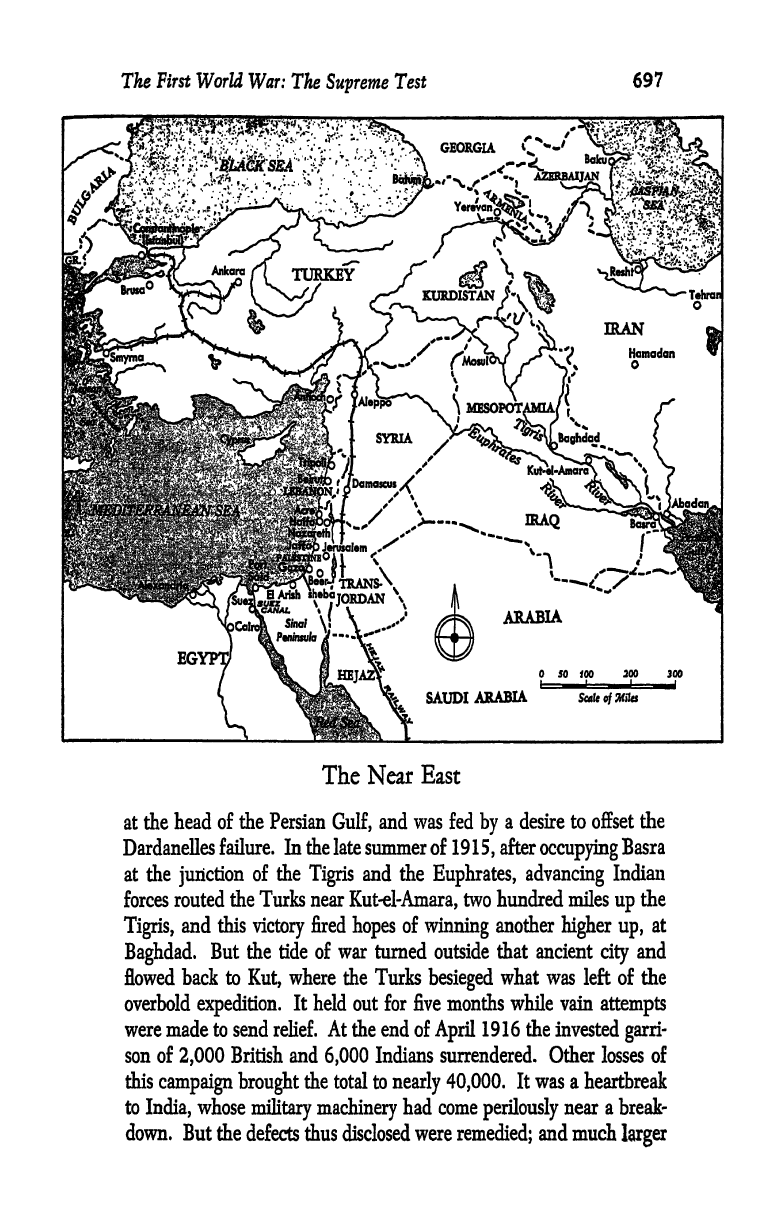
The
First
World
War:
The
Supreme
Test
697
The
Near
East
at the
head
of
the
Persian
Gulf,
and was fed
by
a desire
to offset
the
Dardanelles
failure.
In
the
late summer of
19 1 5
,
after
occupying
Basra
at the
junction
of
the
Tigris
and
the
Euphrates,
advancing
Indian
forces
routed
the Turks
near
Kut-el-Amara,
two
hundred miles
up
the
Tigris,
and
this
victory
fired
hopes
of
winning
another
higher
up,
at
Baghdad.
But the tide of war turned outside that ancient
city
and
flowed
back to
Kut,
where the
Turks
besieged
what
was left of the
overbold
expedition.
It
held
out for five months
while vain
attempts
were made to send relief. At the end of
April
1916 the
invested
garri-
son
of
2,000
British and
6,000
Indians surrendered. Other losses of
this
campaign
brought
the
total
to
nearly
40,000.
It
was a
heartbreak
to
India,
whose
military
machinery
had come
perilously
near
a
break-
down.
But the
defects thus
disclosed
were
remedied;
and much
larger

698
CHAPTER THIRTY-FOUR:
forces,
mostly
from
India,
were
gradually
massed
at
the
head
of
the
Gulf
for
another
campaign,
which
effectively
redeemed
the
reputation
of
India
in
her
own
and
others'
eyes.
"Two
British
armies,
wriggling
across
the desert
like
giant pythons,
gradually
swallowed
Turkey
from
the
feet
up
each
taking
a
leg."
6
Mesopotamia
was
one
leg,
Palestine
and
Syria
the other.
The
second
Mesopotamian
campaign
was under
way
in December
1916,
Baghdad
fell
in
March
1917,
and
the
German-Turkish
dream
of
an
advance
on
India
was
then
shattered.
Operations against
the Turks
on
the
upper
Tigris
and
Euphrates
continued,
with a
pause
during
the
summer
when
the
pitiless
sun was
more
to be feared
than the
enemy.
Though
the
victors
had
achieved their
main
objective
in
Mesopotamia,
their
main-
tenance
of
pressure
there
prevented
the
enemy
from
throwing greater
weight
against
the
British advance in Palestine.
Until the
summer
of 1916
the
British
in
Egypt
had little
thought
of
an
advance
into
the
Holy
Land,
their main
concern
being
defense.
On
the
west the
desert
tribes,
which were
bound
together
in
the
Moslem
brotherhood or
sect
known as the
Senussi,
7
became
actively
hostile
in
November
1915.
But
early
in
the
new
year
a
composite
force
including
troops
from
India,
South
Africa,
Australia,
and
New
Zealand
struck
back
and
defeated
the
Senussi.
On
the
east the
British
pushed
out
their
defenses
of the
Suez
in
the
expectation
of
having
to
hold
back a
big
Turkish
army
released
from
the
Dardanelles.
In the
spring
of
1916
some
of
their
newly
established
advance
posts
were
wiped
out
by
the
enemy.
The
crisis
came
in
the
middle of
the
summer
when
a
Turkish
force,
strengthened
by
German
units
and
led
by
a
resolute
German
general,
made
a
last
desperate
effort to
gain
the
Canal
and
was
com-
pelled
to
withdraw,
thanks
largely
to the
mounted
Anzacs.
In the
ensuing
campaign
around
the
eastern
end
of
tie
Mediter-
ranean,
this
division
of
dominion
cavalry
continued
to
play
a
prominent
part
to
the
very
last,
and
Indian
units
distinguished
themselves
too.
Just
before
Christmas
1916
the
British
army
leaped
to
El
Arish,
and
three
weeks
later it
drove
the
foe
from the
rest
of
northern
Sinai.
But
Gaza,
the
fortress
guarding
the
gateway
of
Palestine,
was a
harder
nut
to
crack;
and it
defied
capture
until
November
1917.
The
invasion
and
conquest
of
southern
Palestine,
which
followed,
was
greatly
assisted
Liddell
Hart,
The
War
in
OutLine,
p.
134.
*
So calkd
after
their
founder,
die
shiek
who
initiated
the
religious
revival
referred to
on n. 672.
^
on
p.
672.
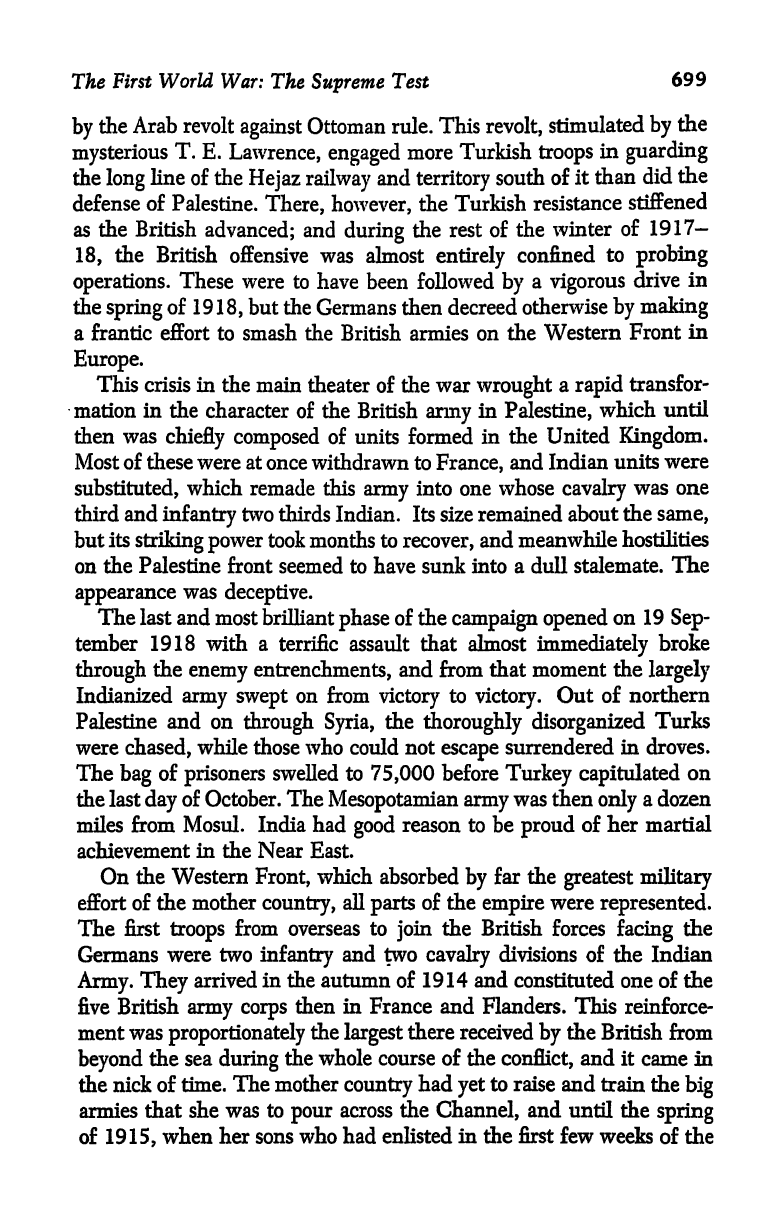
The
First World
War:
The
Supreme
Test
699
by
the
Arab
revolt
against
Ottoman
rule.
This
revolt,
stimulated
by
the
mysterious
T.
E.
Lawrence,
engaged
more
Turkish
troops
in
guarding
the
long
line
of the
Hejaz
railway
and
territory
south
of
it
than
did
the
defense
of
Palestine.
There,
however,
the
Turkish
resistance
stiffened
as
the
British
advanced;
and
during
the
rest of
the
winter
of
1917
18,
the
British
offensive
was almost
entirely
confined
to
probing
operations.
These were to have
been followed
by
a
vigorous
drive
in
the
spring
of
1918,
but the
Germans then
decreed
otherwise
by
making
a frantic
effort
to smash the British armies on
the Western
Front
in
Europe.
This crisis in the
main
theater
of the
war
wrought
a
rapid
transfor-
mation
in
the
character
of the British
army
in
Palestine,
which
until
then
was
chiefly
composed
of units formed
in
the United
Kingdom.
Most
of
these
were
at
once
withdrawn to
France,
and Indian
units
were
substituted,
which
remade
this
army
into one
whose
cavalry
was
one
third and
infantry
two
thirds Indian.
Its
size
remained about
the
same,
but
its
striking power
took
months
to
recover,
and meanwhile
hostilities
on the Palestine
front
seemed
to have sunk into
a
dull
stalemate.
The
appearance
was
deceptive.
The last
and most brilliant
phase
of the
campaign
opened
on 19
Sep-
tember
1918
with
a
terrific
assault
that almost
immediately
broke
through
the
enemy
entrenchments,
and from
that moment
the
largely
Indianized
army
swept
on from
victory
to
victory.
Out
of
northern
Palestine and on
through
Syria,
the
thoroughly disorganized
Turks
were
chased,
while those who could
not
escape
surrendered
in droves.
The
bag
of
prisoners
swelled to
75,000
before
Turkey capitulated
on
the last
day
of October. The
Mesopotamian
army
was then
only
a
dozen
miles
from
Mosul. India
had
good
reason to be
proud
of
her martial
achievement
in
the Near
East.
On
the
Western
Front,
which
absorbed
by
far
the
greatest
military
effort of
the mother
country,
all
parts
of
the
empire
were
represented.
The
first
troops
from overseas to
join
the
British
forces
facing
the
Germans
were two
infantry
and two
cavalry
divisions of
the
Indian
Army. They
arrived
in
the autumn
of
1914 and
constituted one of the
five British
army
corps
then in France
and Flanders. This
reinforce-
ment was
proportionately
the
largest
there
received
by
the
British
from
beyond
the sea
during
the whole course of
the
conflict,
and
it
came in
the
nick of time.
The
mother
country
had
yet
to
raise
and
train
the
big
armies that she was
to
pour
across the
Channel,
and
until the
spring
of
1915,
when her sons who had
enlisted
in the
first
few
weeks
of
the
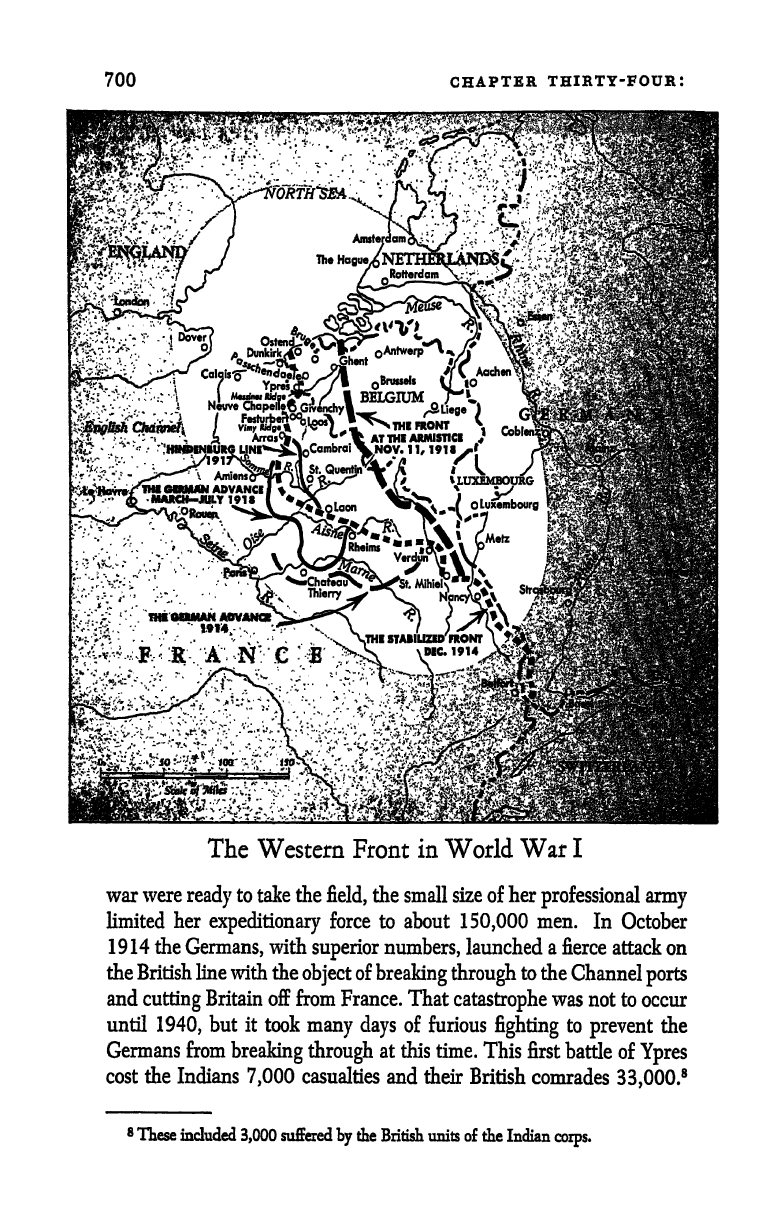
700
CHAPTER
THIRTY-FOUR:
The Western
Front
in
World
War
I
war
were
ready
to take the
field,
the small size of
her
professional army
limited
her
expeditionary
force
to
about
150,000
men.
In
October
1914 the
Germans,
with
superior
numbers,
launched
a
fierce
attack
on
the
British line
with the
object
of
breaking through
to the
Channel
ports
and
cutting
Britain off
from France. That
catastrophe
was not
to
occur
until
1940,
but it
took
many
days
of furious
fighting
to
prevent
the
Germans
from
breaking through
at this time.
This
first
battle
of
Ypres
cost
the
Indians
7,000
casualties
and their British
comrades
33,000.
8
8
These
included
3,000
suffered
by
die British units of
the
Indian
corps.
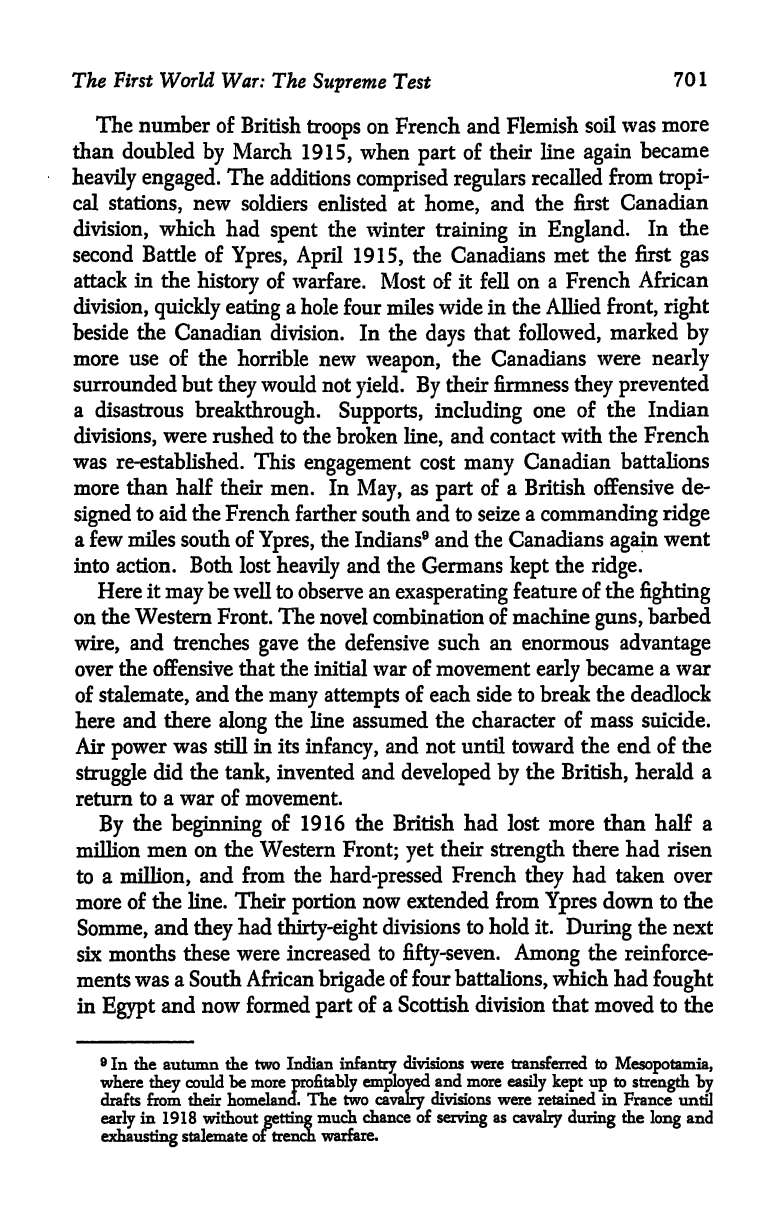
The
First
World War:
The
Supreme
Test
701
The
number of
British
troops
on French and
Flemish
soil
was
more
than doubled
by
March
1915,
when
part
of their line
again
became
heavily
engaged.
The
additions
comprised
regulars
recalled
from
tropi-
cal
stations,
new
soldiers
enlisted at
home,
and
the
first Canadian
division,
which
had
spent
the winter
training
in
England.
In
the
second
Battle
of
Ypres,
April
1915,
the Canadians
met
the
first
gas
attack
in
the
history
of
warfare. Most of it fell
on
a French
African
division,
quickly
eating
a
hole four miles wide
in the
Allied
front,
right
beside
the
Canadian
division. In
the
days
that
followed,
marked
by
more
use
of the
horrible
new
weapon,
the
Canadians
were
nearly
surrounded but
they
would not
yield.
By
their
firmness
they prevented
a
disastrous
breakthrough. Supports, including
one
of
the Indian
divisions,
were
rushed
to the broken
line,
and contact
with
the French
was
re-established. This
engagement
cost
many
Canadian
battalions
more
than half
their
men. In
May,
as
part
of a
British offensive
de-
signed
to
aid
the
French
farther south and
to seize
a
commanding ridge
a few miles south
of
Ypres,
the Indians
9
and
the Canadians
again
went
into
action. Both
lost
heavily
and
the
Germans
kept
the
ridge.
Here
it
may
be well to
observe
an
exasperating
feature of
the
fighting
on
the
Western
Front. The
novel
combination of
machine
guns,
barbed
wire,
and trenches
gave
the defensive such
an
enormous
advantage
over
the
offensive
that
the initial war of movement
early
became
a
war
of
stalemate,
and
the
many
attempts
of each side
to break the deadlock
here
and there
along
the
line assumed
the
character
of mass suicide.
Air
power
was still
in its
infancy,
and
not
until
toward the
end
of
the
struggle
did
the
tank,
invented and
developed
by
the
British,
herald
a
return
to
a war
of
movement.
By
the
beginning
of 1916
the
British
had lost
more
than half
a
million
men on
the Western
Front;
yet
their
strength
there
had
risen
to
a
million,
and from
the
hard-pressed
French
they
had
taken over
more
of
the line. Their
portion
now extended from
Ypres
down to the
Somme,
and
they
had
thirty-eight
divisions
to
hold
it.
During
the next
six
months
these
were increased
to
fifty-seven.
Among
the
reinforce-
ments
was a
South African
brigade
of
four
battalions,
which had
fought
in
Egypt
and now
formed
part
of a Scottish
division
that
moved to the
9
In die autumn the two
Indian
infantry
divisions were transferred to
Mesopotamia,
where
they
could be
more
profitably
employed
and
more
easily
kept up
to
strength
by
drafts from
their
homeland.
The
two
cavalry
divisions were
retained in
France until
early
in 1918 without
getting
much
chance of
serving
as
cavalry
during
the
long
and
exhausting
stalemate oi
trench
warfare.
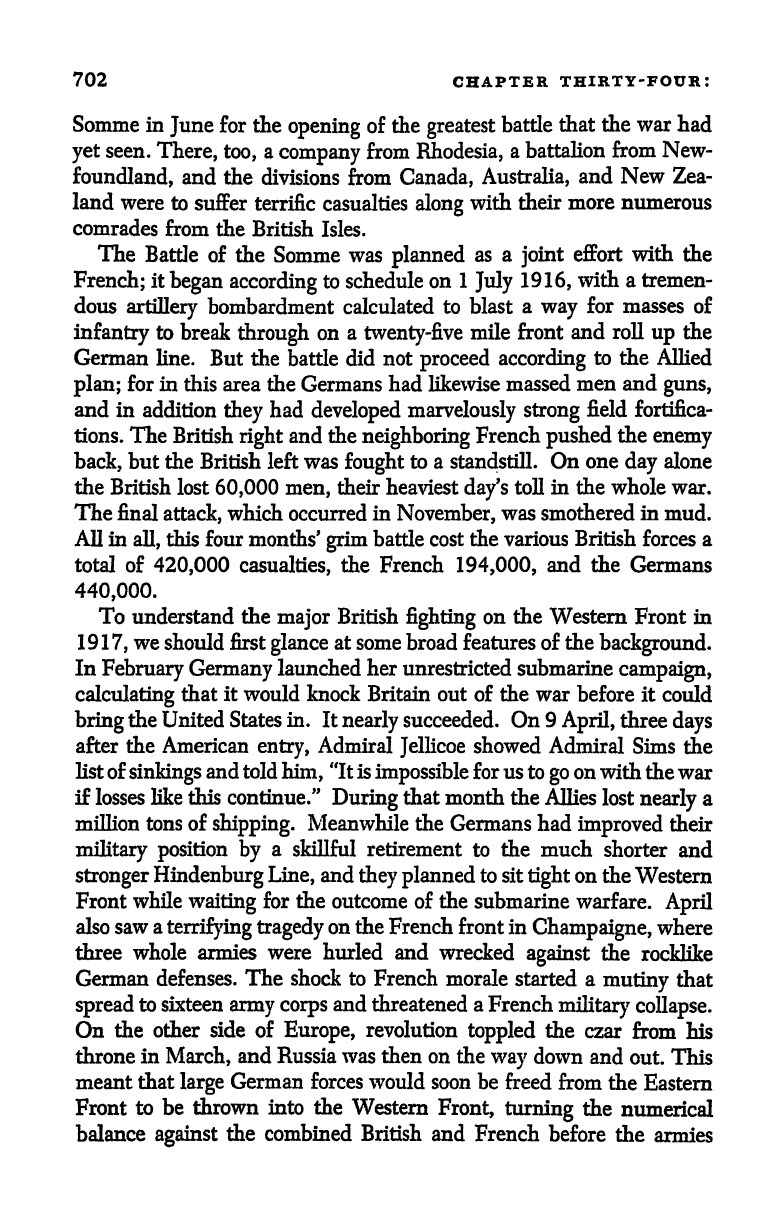
702
CHAPTER
THIRTY-FOUR:
Somme
in
June
for the
opening
of the
greatest
battle
that the
war
had
yet
seen.
There, too,
a
company
from
Rhodesia,
a battalion
from
New-
foundland,
and the
divisions from
Canada,
Australia,
and
New Zea-
land were
to suffer
terrific
casualties
along
with their
more
numerous
comrades from
the
British
Isles.
The
Battle
of the
Somme
was
planned
as
a
joint
effort
with
the
French;
it
began
according
to
schedule
on
1
July
1916,
with
a
tremen-
dous
artillery
bombardment
calculated
to blast
a
way
for
masses of
infantry
to break
through
on
a
twenty-five
mile front
and
roll
up
the
German
line.
But the
battle did
not
proceed
according
to the
Allied
plan;
for
in this area the
Germans
had
likewise
massed
men
and
guns,
and in
addition
they
had
developed
marvelously
strong
field fortifica-
tions.
The
British
right
and the
neighboring
French
pushed
the
enemy
back,
but the British left was
fought
to a standstill. On
one
day
alone
the
British lost
60,000
men,
their
heaviest
day's
toll in the whole war.
The
final
attack,
which occurred
in
November,
was smothered
in
mud.
All
in
all,
this four months'
grim
battle cost
the various British
forces
a
total of
420,000
casualties,
the French
194,000,
and the
Germans
440,000.
To understand
the
major
British
fighting
on
the
Western Front in
1917,
we
should first
glance
at
some
broad
features
of
the
background.
In
February
Germany
launched
her
unrestricted submarine
campaign,
calculating
that
it
would knock Britain
out
of the
war before it
could
bring
the
United
States
in.
It
nearly
succeeded. On
9
April,
three
days
after
the American
entry,
Admiral
Jellicoe
showed Admiral Sims
the
list
of
sinkings
and
told
him,
"It
is
impossible
for us to
go
on with
the war
if
losses
like
this continue."
During
that
month the
Allies
lost
nearly
a
million
tons
of
shipping.
Meanwhile
the
Germans had
improved
their
military
position
by
a
skillful retirement
to
the much
shorter
and
stronger
Hindenburg
Line,
and
they planned
to
sit
tight
on the
Western
Front while
waiting
for
the
outcome of the submarine
warfare.
April
also saw
a
terrifying tragedy
on the French front in
Champaigne,
where
three whole
armies
were
hurled and
wrecked
against
the
rocklike
German
defenses.
The
shock
to
French morale
started
a
mutiny
that
spread
to sixteen
army corps
and threatened a French
military
collapse.
On
the
other side
of
Europe,
revolution
toppled
the
czar
from
his
throne
in
March,
and Russia
was
then on
the
way
down
and out.
This
meant that
large
German forces
would soon
be
freed
from
the
Eastern
Front
to
be
thrown
into
the Western
Front,
turning
the
numerical
balance
against
the combined British
and
French
before
the
armies

The
First World War:
The
Supreme
Test
703
that
the
United
States
had
yet
to
raise
and
train
could
come
to
the
rescue
in
the
summer
of
the
following
year.
Early
in 1917 the
British took
over
still more
of
the line
on
their
south,
so
that the
French
could
concentrate
their
strength
for
the
mighty
assault with which
they
hoped
to
win the
war but
nearly
lost
it;
and
to
aid
them
further,
the
British
agreed
to
deliver
a smart
blow
in
the
Arras sector
a week
before
the French
were to strike.
The
British
front
of
attack
was
a
dozen
miles
long;
and
opposite
the
left
of
it
was
a
key
German
position, Vimy
Ridge,
which had
been
transformed
into
a
veritable
fortress. TTie task of
taking
it was
assigned
to
the
Canadian
Corps
and
executed so
brilliantly,
on the
opening
day,
that
when
peace
came
their
government
crowned
the
commanding
site
with
the
princi-
pal
Canadian
war
memorial.
The
seizure
of
Vimy
gave
the
British
a
firm
pivot
on
which
they vainly
tried to
swing.
The
operation
soon
ran
into
such
stiff
resistance
that
the cost
began
to
outweigh
the
local
gain;
but
the French
debacle decided
the British to
keep
on
hammering
until
May,
by
which time
their
whole
advance
had
averaged
no
more
than
three
miles.
For
the rest of
the
year
on the
Western
Front,
the British
fought
practically
alone
against
great
odds.
They
were anxious
to divert
the
attention
of
the
enemy
from
the stricken
French,
and
to
make the
most
of
the short
time
that
Germany
would
still
have to
fight
on two
fronts.
A further
reason
and
a
particular
objective
were
supplied
by
the
Admi-
ralty.
Jellicoe
told
the
war
cabinet
that unless
the
army
captured
the
submarine
nests
on
the
Belgian
coast
he
thought
it
"improbable
that
we could
go
on
with
the
war next
year
for
lack
of
shipping."
The
main
effort
was
therefore
to
drive
in
a
northeasterly
direction
from
the left
end
of
the British line
at
Ypres,
but
that
base had
first
to be
made
more
secure
by
clearing
the
Germans
off
a
ridge
that over-
looked
the
town
from
the south.
The
ridge
area
was too
strong
to be
taken
by
ordinary
assault,
and
since
1914
it had
seen
no serious
fight-
ing;
but
underground
an elaborate
offensive
had been
proceeding
for
a
year
and
a half.
In
the
early
dawn
of
7
June
1917,
along
a front of
about
ten
miles,
a
score
of
huge
mines
charged
with a
million
pounds
of
high
explosive
blew
up
under
the
Germans,
and,
while
the debris
still
hung
in the
air,
three
British
army
corps
began
to
storm the
heights.
They
were
in
firm
possession
of
them
by
nightfall.
A few
days
of stiff
fighting
followed,
during
which
the
Germans
were
pushed
back
until
the
line
immediately
south
of
the
Ypres
salient
was
straightened
out.
Of
the
various
divisions
that
fought
in this
battle,
two
were
Australian,
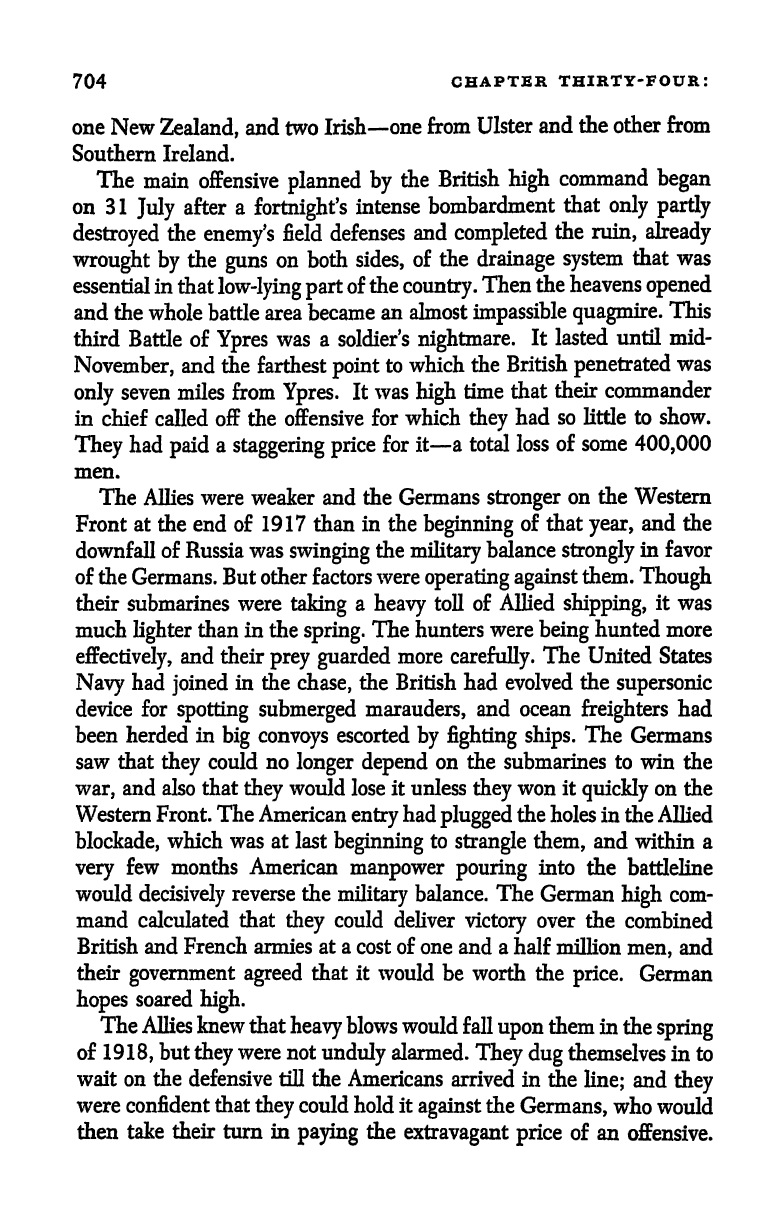
704
CHAPTER
THIRTY-FOUR:
one
New
Zealand,
and
two
Irish
one
from
Ulster
and
the
other
from
Southern
Ireland.
The
main
offensive
planned
by
the
British
high
command
began
on 31
July
after
a
fortnight's
intense
bombardment
that
only partly
destroyed
the
enemy's
field
defenses
and
completed
the
ruin,
already
wrought
by
the
guns
on both
sides,
of
the
drainage
system
that was
essential in that
low-lying
part
of
the
country.
Then
the
heavens
opened
and the
whole battle
area became
an
almost
impassible quagmire.
This
third
Battle
of
Ypres
was a
soldier's
nightmare.
It
lasted
until mid-
November,
and the farthest
point
to
which
the
British
penetrated
was
only
seven miles from
Ypres.
It
was
high
time
that
their
commander
in
chief
called
off the
offensive
for
which
they
had
so little to
show.
They
had
paid
a
staggering
price
for
it
a total loss
of some
400,000
men.
The Allies were weaker and
the
Germans
stronger
on the
Western
Front
at
the end of
1917 than
in
the
beginning
of that
year,
and the
downfall
of
Russia
was
swinging
the
military
balance
strongly
in favor
of
the
Germans. But other
factors were
operating
against
them.
Though
their
submarines were
taking
a
heavy
toll of Allied
shipping,
it
was
much
lighter
than
in the
spring.
The
hunters
were
being
hunted
more
effectively,
and their
prey guarded
more
carefully.
The United States
Navy
had
joined
in the
chase,
the
British
had
evolved
the
supersonic
device
for
spotting submerged
marauders,
and ocean
freighters
had
been herded
in
big convoys
escorted
by
fighting
ships.
The Germans
saw
that
they
could no
longer
depend
on the submarines to
win the
war,
and
also
that
they
would lose it
unless
they
won it
quickly
on the
Western
Front.
The
American
entry
had
plugged
the
holes
in the
Allied
blockade,
which
was
at
last
beginning
to
strangle
them,
and
within a
very
few months American
manpower
pouring
into
the batdeline
would
decisively
reverse the
military
balance.
The
German
high
com-
mand
calculated that
they
could deliver
victory
over the
combined
British and French
armies at
a
cost of one
and
a
half million
men,
and
their
government
agreed
that it
would be
worth
the
price.
German
hopes
soared
high.
The Allies
knew that
heavy
blows
would fall
upon
them
in
the
spring
of
1918,
but
they
were
not
unduly
alarmed.
They
dug
themselves in
to
wait on
the
defensive
till
the
Americans
arrived
in
the
line;
and
they
were confident
that
they
could
hold
it
against
the
Germans,
who would
then
take
their turn in
paying
the
extravagant price
of
an
offensive.
